DALLAS — The first manned heavier-than-air aircraft, the Wright Flyer was the simplest form of aircraft, with basic controls and no proper seats.
The Wright brothers laid the groundwork for future controlled aircraft. After more than 100 years, we have aircraft carrying more than 800 passengers at a time.
With the help of technology and R&D, we have arrived at a point where big aircraft are no longer our primary concern; safety is, a concern that has been addressed by the world's largest aerospace companies. From having the world's largest facilities to building aircraft in days, the aviation industry has come a long way and is still pushing the envelope.
The criteria used to select the largest aircraft vary according to size, capacity, weight, and other parameters. For this article, we have used the maximum seating capacity of the aircraft.
Today, we take a look at the top 10 largest passenger aircraft still flying today. For a better understanding of this ranking, we have grouped aircraft variants rather than listing them individually.

10. Boeing 757
At number 10, we have the narrow-body aircraft designed and built by Boeing's commercial airplane (BCA) division, the Boeing 757. The aircraft is a twinjet successor to the Boeing 727 (the only trijet developed by Boeing). It is powered by Rolls-Royce RB211 or Pratt & Whitney PW2000 turbofan engines producing 36,600–43,500 lbf (163–193 kN) and located underwing.
The Boeing 757-200 made its first flight on February 19, 1982. Following the success of the Boeing 727, one of the best-selling aircraft of the 20th century. Boeing wanted to improve its seating capacity, and with an upturn in the industry and an interest in a new development plan, they designed the Boeing 757 jet.
The 757 has a range of 3,915 nmi/7,250 km (-200 variant), a length of 178 ft 7 in/54.4 m (-300 variant), and a fuselage width of 148 in/3.76 m. The type is capable of flying at Mach 0.86 (496 kn; 918 km/h) and has a wingspan of 124 ft 6in / 38 m.
The aerospace giant obtained its first launch customer with Eastern Air Lines (EA) and entered service with them on January 1, 1983. Boeing produced many variants of the 757, which are designated as the 757-200 (the original variant), 757-200PF, 757-200M, 757-200SF/PCF (the cargo variants), and 757-300 (the extended version). They produced 55 Boeing 757-300, and all were in service as of 2018.
The Boeing 757-200 is certified for a maximum capacity of 239 passengers, while the Boeing 757-300 is certified for a maximum capacity of 295 passengers. The largest 757 operator is Delta Air Lines (DL), with a fleet of 127 such aircraft. Overall, BCA produced a total of 1049 Boeing 757s until 2004, with maximum orders for 757-200s.

9. Boeing 767
At the ninth spot, we have the Boeing 767, a twin-aisle jet aircraft designed and built by Boeing. The first wide-body twinjet developed by Boeing can be powered by three turbofan options. Customers can choose between General Electric (GE) CF6, Rolls-Royce (RR) RB211, or Pratt & Whitney (P&W) JT9D turbofans to get propulsive forces ranging from 48,000–60,600 lbf (214–270 kN).
The Boeing 767-200 prototype first flew on September 26, 1981. As a replacement for 707s, BCA started production of the 7X7 to capture mid-size, high-density markets. The BCA began working on 767 concurrently with 757, and both were released in the same year. To date, BCA has delivered 1271 Boeing 767s, with 106 on its order book. FedEx Express (FX) is the largest operator of 767Fs (the freighter model), while DL is the largest operator of passenger 767s.
The aircraft has different ranges due to its variants, the longest-range variant is the Boeing 767-200ER with 6,590 nmi (12,200 km). While there are three fuselage lengths, the longest is the 767-400ER, with a length of 201 ft 4 in/61.37 m and a wingspan of 170 ft 4 in/51.92 m. The Boeing 767 has a maximum speed of 459–486 kn (850–900 km/h) at an altitude of 39,000 ft (12,000 m).
Boeing launched the 767-200 with United Airlines (UA) on September 8, 1982. BCA developed various variants ranging from the 767-200 (original), the 767-2C (commercial freighter version of the 767-200), the 767-200ER, the 767-300, the 767-300ER, the 767-300F, and the 767-400ER. The 400ER, the latter variant, was the first Boeing wide-body jet with two fuselage expanses. In 2001, Boeing canceled the proposed variants of the Boeing 767-X and 767-400ERX.
Boeing 767s with multiple variants have different seating capacities. With single-class seating arrangements, the Boeing 767-200 and -200ER can have 245 seats, while the Boeing 767-400ER can carry up to 375 passengers. The smaller variants of both Boeing 757s and 767s have comparable seating capacities.

8. Ilyushin Il-96
The first and only Russian aircraft on our list, the Ilyushin Il-96, is a four-engine jet designed by Ilyushin and built by the Voronezh Aircraft Production Association in Russia. It evolved from the Ilyushin Il-86, the Soviet Union's first widebody aircraft. The Il-96 is powered by four high-bypass turbofan engines, the Aviadvigatel PS-90, and it produces a thrust of 16000 kgf (157 kN, 35,300 lbf).
The Ilyushin Il-96 completed its maiden flight on September 28, 1988. Only 30 were produced, and the type is considered an inferior plane among the major planes developed by Airbus and Boeing.
Voronezh nearly ceased production of the Ilyushin Il-96 in 2014, but its cargo variant is still in production. Following sanctions on Russia due to the Russia-Ukraine war, a former KGB official and the CEO of Rostec, Sergey Chemezov, announced that the company would do mass production of the relaunched Ilyushin Il-96. Rostec, formerly Rostekhnologii (literally "Russian Technologies"), is a Russian state-owned defense conglomerate headquartered in Moscow.
The Ilyushin II-96 has four major variants with similar ranges, but one has a slightly longer range of 11,482 km (6,195 nmi). If we talk about the dimensions of the Il-96, one of its longest variants has a length of 64.69 m (212 ft 3 in) and a wingspan of 60.12 m (197 ft 3 in).
The type entered service on December 29, 1992, with Aeroflot (SU), Russia's state-owned flag carrier. With dozens of variants, four are major ones and are named Il-96-300 (the original variant), Il-96M, Il-96T, and Il-96-400 (the largest). Currently, only a few airlines and defense divisions fly it. Rossiya Airlines (FV), operated for the Government of Russia, is the largest operator of the Ilyushin Il-96.
Out of four major variants, three of them are passenger ones, Ilyushin Il-96-300 has a seating capacity for 300 passengers; the Il-96M has around 420 seats, and finally, the Il-96-400 has 436 seats for passengers, which is only four seats less than Boeing 787s.

7. Boeing 787 Dreamliner
At number seven is the most advanced airliner, the Boeing 787 Dreamliner. After scrapping its Sonic Cruiser project, Boeing started the development of an efficient airliner in 2003. Within 14 months, the company launched the Boeing 787 program with orders from ANA All Nippon Airways (NH) for 50 jets.
After some delays, the Boeing 787-8 performed its maiden flight on December 15, 2009. Boeing rolled out the Boeing 787 to replace the less efficient Boeing 767. The type went head-to-head with the Airbus A330.
The modern airliner has three passenger variants, all with different ranges. The Boeing 787-8 has a range of 7,355 nmi (13,620 km), while the Boeing 787-9 can travel up to 7,635 nmi (14,140 km), the longest among others despite having more seats than -8s. Finally, the Boeing 787-10 has a range of 6,430 nmi (11,910 km).
The Boeing 787-8 has a length of 186 ft 1 in (56.72 m), the Boeing 787-9 has 206 ft 1 in (62.81 m) and the Boeing 787-10 has 224 ft (68.28 m). The wingspan is about 197 ft 3 in (60.12 m) long.
ANA became the launch customer of the Dreamliner on October 26, 2011. Boeing also initially planned a short-haul version named the Boeing 787-3, but due to a delay in 787-8 production, the company stopped the -3 production. Boeing is also planning to develop a freighter version of the Boeing 787, but there is no clear timeframe for the program.
The innovative Boeing 787 is one of the more successful long-haul aircraft produced by BCA, with more than 1000 deliveries and around 500 on order. American Airlines (AA) and NH are the two largest operators of Boeing 787s.
The Boeing 787-8 can carry 381 passengers; the Boeing 787-9 can carry 420 passengers; and the longest variant, the Boeing 787-10, can carry 440 passengers.

6. Airbus A330
The widebody Airbus A330 comes in at number six. The A330 is a successor to the A300, Airbus' first aircraft of the mid-1970s. The A330 twinjet can be powered by three options (the first aircraft with three options by Airbus): the GE CF6, the P&W PW4000, and the RR Trent 700, which produces 64,500–71,100 lbf (287–316 kN).
The Airbus A330-300 (original variant) completed its maiden flight on November 2, 1992. The type's airframe is similar to that of the A340's earlier variants, as Airbus started working on them in parallel and received combined orders. Despite differences in the engine and some systems, the bodies are very similar. So far, Airbus has delivered 1,559 A330s and has a backlog of 215 aircraft. Delta Air Lines (DL) and Turkish Airlines (TK) are among the largest operators of A330s.
The aircraft have different ranges: the A330-200 has 13,450 km (7,260 nmi), while its freighter version has 7,400 km (4,000 nmi) and the A330-300 has 11,750 km (6,340 nmi). If we look at their lengths, the A330-200 is 58.82 m (192.98 ft) long, while the A330-300 is 63.66 m (208.86 ft) and it has a wingspan of 60.3 m (197.83 ft).
Airbus launched the A330-300 on January 17, 1994, with Air Inter. The company produced three variants as mentioned above and two new variants using the same fuselage, renaming them A330-800 and A330-900, respectively. Later, Airbus renamed all previous variants CEO and all subsequent variants NEO. We will explore the differences and similarities in a later article.
Different variants have different capacities. The Airbus A330-300 has 440 seats, while the A330-200 has 409 seats. The A330-800 has 406 seats, while the A330-900 has a seating capacity of 460 passengers. So, despite having a similar fuselage, the European planemaker increased seating capacity in the -900 model with high-density cabin modifications.
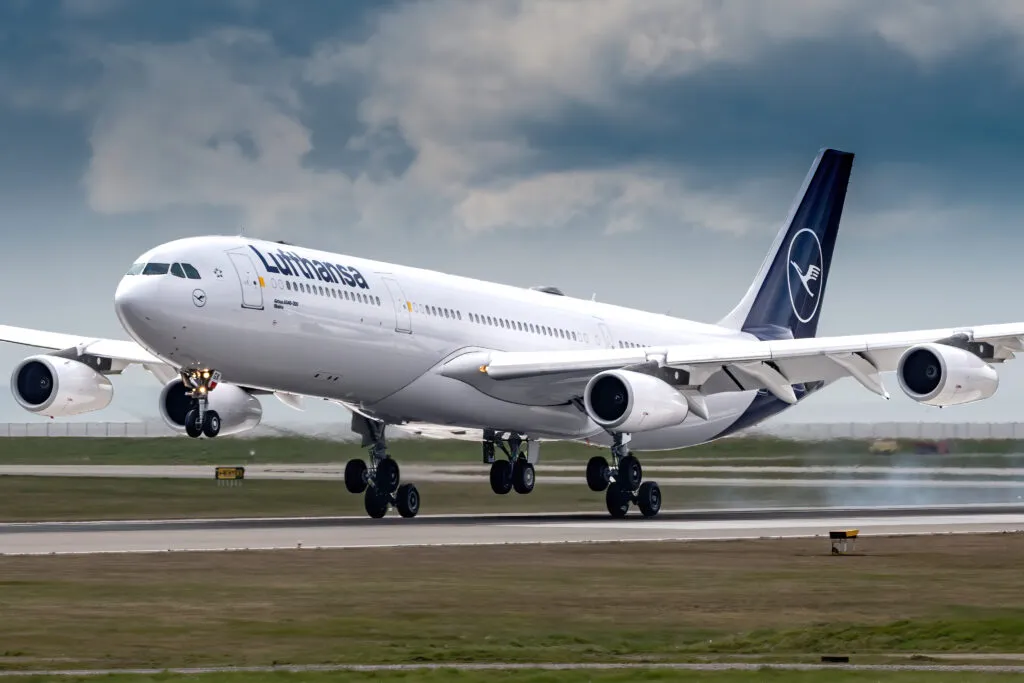
5. Airbus A340
At number five, we have the Airbus A340, a long-range, wide-body airliner. Similar to the A330, the A340 was developed from the A300 base model. Its early variant is propelled by CFM56s with 138.78–151.24 kN (31,200–34,000 lbf) while later variants are powered by the RR Trent 500 engine, giving 248.12–275.35 kN (55,780–61,902 lbf) thrust.
The A340-300 (original variant) first took to the skies on October 25, 1991. Airbus has delivered 377 A340s. In 2012, the company announced that it would stop the production of A340s as it shifted its resources to producing more A350s.
The aircraft has four passenger variants with different ranges. A340-200 has a range of 12,400 km / 6,700 nmi, A340-300 with 13,500 km / 7,300 nmi, A340-500 with 16,670 km / 9,000 nmi and finally A340-600 has a range of 14,450 km / 7,800 nmi. Length varies from 59.39 m/194 ft 10 in (A340-200) to 74.77 m/245 ft 3 in (A340-600). Interestingly A340-200/300 has a smaller wingspan than that of the A340-500/600, which is 63.45 m/208.17 ft.
The Airbus A340 was launched with Lufthansa (LH) and Air France (AF) on March 15, 1993. Many airlines are operating this aircraft, and as of December 2022, out of 377, around 200 were in service. LH is the largest operator of the A340, with 34 in service.
All four passenger variants have unique seating arrangements. The A340-200 can accommodate up to 375 passengers, and the A340-300 is a widely used airliner with a maximum seating capacity of 440 passengers. While the later variants (the -500s) are equivalent to the -200s, the A340-600 can accommodate up to 475 passengers.
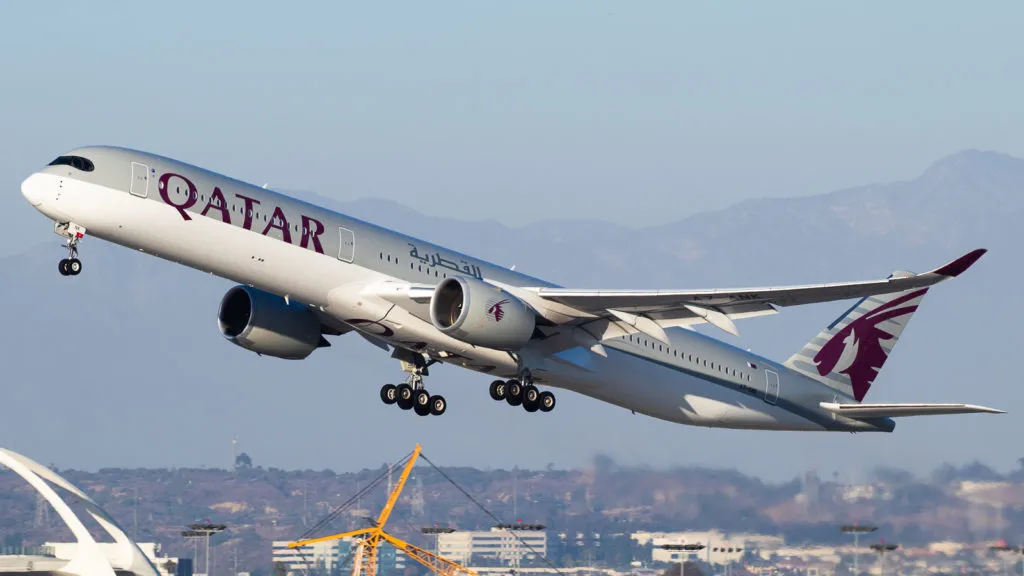
4. Airbus A350XWB
At number four we have the Airbus A350 Extra Wide Body (XWB), an ultra-long haul airliner designed and built by Airbus. It is the first Airbus aircraft built widely using carbon-fiber-reinforced polymers. It has impressive dual RR Trent XWB turbofan engines to propel aircraft. with each of Trent XWB capable of producing thrusts of 84,200 lbf/374.5 kN for -900 and 97,000 lbf/431.5 kN for the -1000 variant.
The Airbus A350-900 (original variant) performed its maiden flight on June 14, 2013. The aircraft is a completely new airliner and is produced around a nine-abreast economy cross-section. The airliner has two main passenger variants and one freighter model.
The passenger variants have a massive range and are involved in many record-breaking flights. The Airbus A350-900 has a range of 15,372 km / 8,300 nmi, while its longest variant, the A350-1000 has a range of 16,100 km (8,700 nmi). The Airbus A350F model has a shorter range of 8,704 km (4,700 nmi), almost half of the -1000 model.
The Airbus A350-900 was launched with Qatar Airways (QR) on January 15, 2015. The European manufacturer has delivered 521 A350s and has a backlog of 441 aircraft. The freighter version of the A350-F is yet to be delivered by the company. Singapore Airlines (SQ) is the largest operator of A350s with 61.
With two passenger variants, the Airbus A350-900 can accommodate up to 440 passengers, similar to the Boeing 787-10 and the A340. While the A350-1000 can carry up to 480 passengers, it is more than twice as large as the A320 family of aircraft.
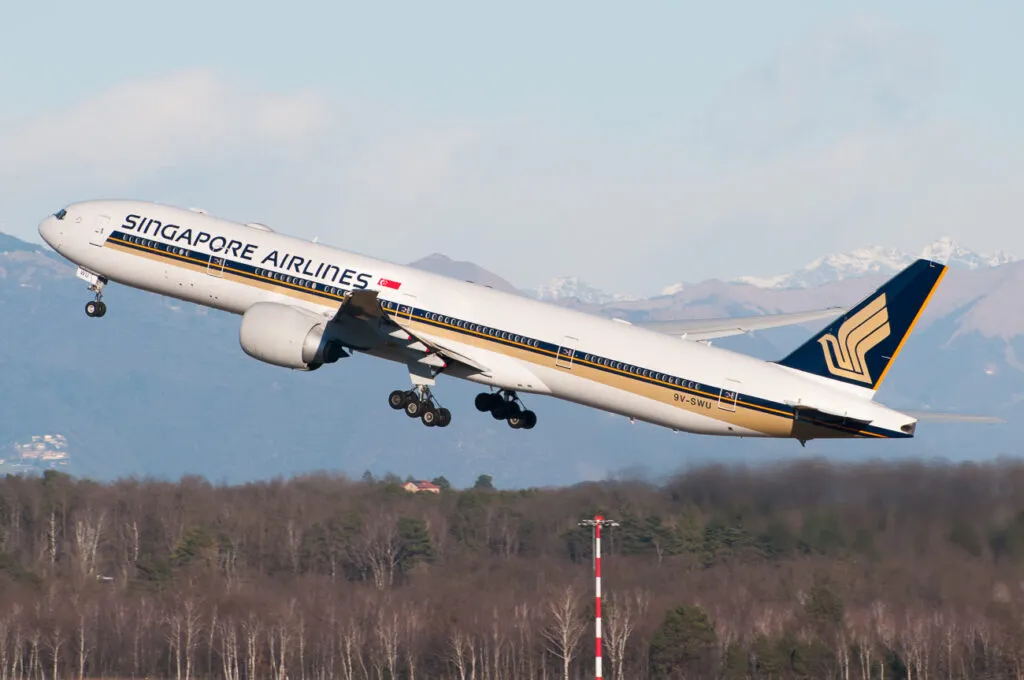
3. Boeing 777
At number three, we have the long-range, wide-body Boeing 777. It is the world's largest twin-engine airliner, obtaining its thrust via multiple engine variants. The classic 777s are powered by the 77,200–98,000 lbf (343–436 kN) thrust of the GE90, the P&W PW4000, or the Rolls-Royce Trent 800 turbofan engines. The 777X is powered by GE9X, the world's most powerful turbofan engine developed by General Electric.
The Boeing 777-200 (original variant) performed its maiden flight on June 12, 1994. To date, Boeing has delivered more than 1,700 Boeing 777s and has a backlog of 440 aircraft. Emirates (EK), SQ, UA, International Lease Finance Corporation (IFLC), and AA are among the largest operators of Boeing 777s. EK has around 163 Boeing 777s.
With many passenger and freighter variants, the type has major range differences. The Boeing 777-200 has a range of 5,240 nmi/9,700 km, while the Boeing 777-200ER has a range of 7,065 nmi/13,080 km. The Boeing 777-300 has a range of 6,030 nmi/11,165 km, while the 777-300ER has a range of 7,370 nmi/13,649 km range. Finally, the 777-200LR has the longest range, clocking at 8,555 nmi/15,843 km. With these numbers, Triple Sevens are capable of flying record-breaking ultralong routes.
The Boeing 777 entered service with UA on June 7, 1995. Since then, it has been operated on a point-to-point model rather than a hub-and-spoke one around the world. The Boeing 777X, which has completed test flights, is expected to be in service by 2025.
All passenger models have distinctive seating arrangements, Boeing 777-200/200ER has a seating capacity of 440 passengers. The Boeing 777-300/300ER can accommodate 550 passengers, and the Boeing 777X will accommodate around 426 passengers (2-class seating) and more in a 1-class configuration.
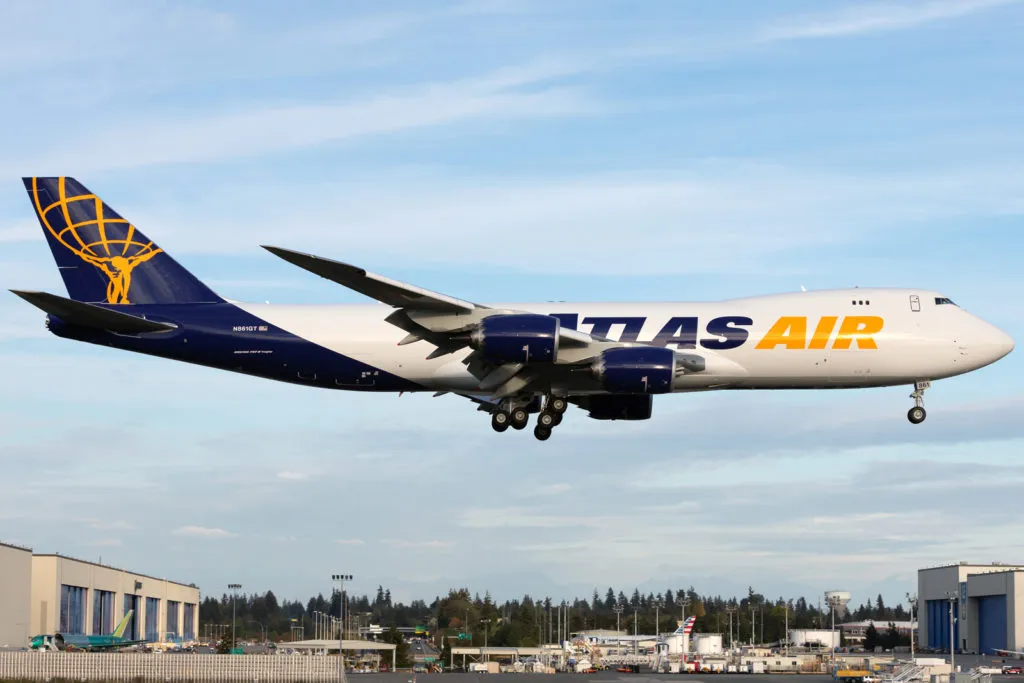
2. Boeing 747
At number two, we have the Queen of the Skies The iconic Boeing 747 is a semi-double-decker, long-range wide-body airliner. The aircraft's design is credited to Joe Sutter, who left the Boeing 737 development program in 1965. The type is the world's first twin-deck airliner and was rolled out of the Boeing Everett factory on September 30, 1968.
The Boeing 747-100 (original variant) flew for the first time on February 9, 1969. The quadjet was powered at first by P&W JT9D engines, then by GE CF6 or RR RB211 engines, and finally by PW4000 and GEnX-2B engines. The aircraft is capable of flying at a maximum speed of 939 km/h (507 mph), or Mach 0.92.
The ranges of the American airliner variants are distinct. The Boeing 747-100 has a range of 4,620 nautical miles (8,560 kilometers), while the Boeing 747-8 has a range of 7,730 nautical miles (14,320 kilometers). Length varies from 184 ft 9 in (56.3 m) to 250 ft 2 in (76.25 m). while its wingspan ranges from 195 ft 8 in (59.6 m) up to 224 ft 7 in (68.5 m) long.
The Boeing 747 launched with Pan Am on January 22, 1970. Boeing has delivered all 1,574 Boeing 747s to customers to date. The last Boeing 747 delivery to Atlas Air (5Y) took place on January 31, 2023.
All of the Jumbo variants have outstanding features and seating arrangements. Boeing's 747SP has 400 seats; the 747-100 has 440 seats; the 747-200B has 550 seats; the 747-300 has 550 seats; and, most importantly, Boeing's 747-400 has 660 seats; and the 747-8 has around 605 seats.
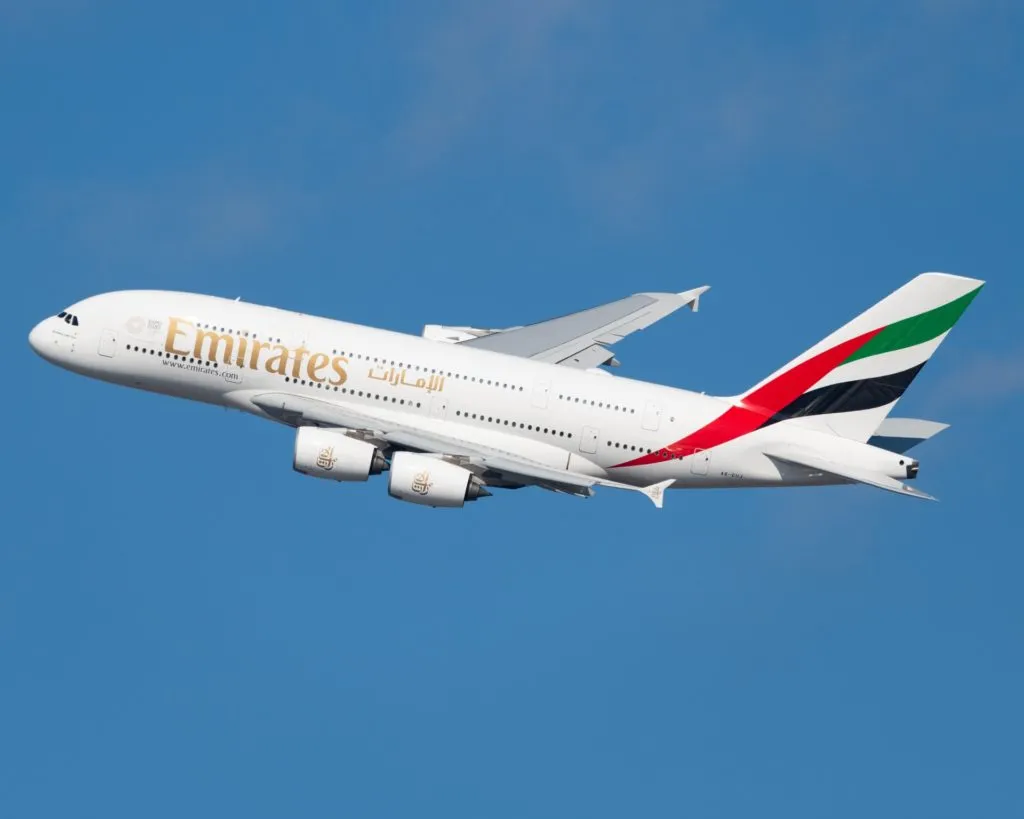
1. Airbus A380
The top spot goes to the Superjumbo jet. The Airbus A380 widebody airliner is the world's first and only aircraft with two full decks. The world's largest passenger carrier is powered by four extremely powerful Engine Alliance GP7200 or Rolls-Royce Trent 900 turbofans, each producing a thrust of 332.44–356.81 kN (74,740–80,210 lbf).
Despite facing delays due to wiring problems, the first Airbus A380-841 (original variant) performed its maiden flight on April 27, 2005. At the time. Airbus' chief test pilot, Jacques Rosay, said that flying the A380 had been "like handling a bicycle."
The Airbus A380 was to go head-to-head with the Boeing 747, but Airbus Very Large Aircraft (VLA) data proved otherwise. The European manufacturer received six times fewer orders for its A380s compared to those for the Boeing 747s.
Production of the A380 came to an end in 2021. As of December 2021, Airbus had delivered 251 A380s to around 20 operators across the globe. EK is the largest operator of the A380, and it has 120 Superjumbos, almost half of the total production.
Airbus has developed a few sub-variants of the A380, with a similar range of 14,800 km/9,200 mi. The type is 72.72 m (238 ft 7 in) in length and has a wingspan of 79.75 m (261 ft 8 in). The A380 is capable of a cruise speed of 903 km/h (561 mph; 488 knots), or Mach 0.85.
The A380 entered service on October 25, 2007, with Singapore Airlines (SQ) as the launch customer. Airbus later planned to build a few more efficient variants, such as the Airbus A380F (freighter model), A380-900 (stretched variant), A380neo (fuel-efficient and larger version), and A380plus (new winglet variant).
The world's largest passenger aircraft can accommodate a maximum of 853 passengers, 200 more than the Boeing 747-400. In its 2-seat configuration, it can accommodate 575 passengers, almost three times more than the A320s.

Bottom Line
With the Airbus A380, we complete the list of the world's largest passenger aircraft, not to be confused with the longest passenger aircraft. There are around 19 types of commercial aircraft in production. Six of these 19 have made our top ten list of the largest passenger airliners.
If we compare existing passenger jets with cargo jets, the latter are larger and heavier. A few to name are the Stratolaunch, the Hughes H-4 Hercules, the Antonov An-225 Mriya (destroyed in the Russia-Ukraine war), the Boeing Dreamlifter, and the Airbus Beluga XL.
Airbus and Boeing combined have nine of the ten largest passenger aircraft in the world. If we consider the most produced aircraft to date out of the above-mentioned aircraft, Boeing is the winner.
Various aerospace companies have produced over 50 different and unique commercial aircraft prototypes to date. Many aircraft have taken off for the last time, and some have just been retired, such as the McDonnell Douglas MD-90 (172 seats) and the Fokker F28 Fellowship (85 seats).
All the aforementioned aircraft continue to crisscross the skies and will continue to do so until they reach their maximum fuselage age or when their operators retire them. We might see the retirement of the Boeing 757 within a decade, but the largest of all, the A380s and Boeing 747s, are expected to fly until 2040.
Will we ever see an aerospace company break the record of the Airbus A380 as the largest passenger airliner in the world? Do let us know in the comment section of our social media channels.




